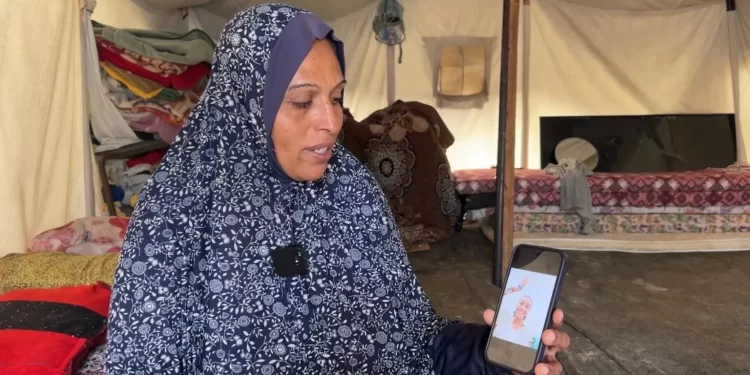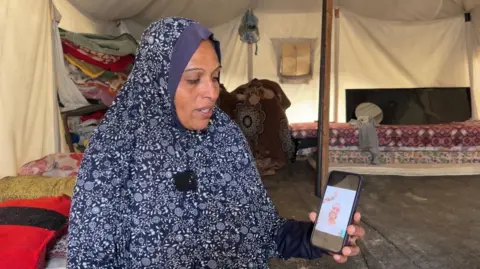 BBC
BBCEverything gets mixed up together. The child’s multi-coloured backpack. A running shoe. A steel pot perforated by shrapnel. Bits of beds, chairs, cookers, lampshades; the glass of broken windows, mirrors, drinking glasses. Scraps of clothing.
These last shredded, dust covered items can be markers. Often they belong to the dead lying near the surface of the rubble.
“Since the Israeli occupation forces withdrew from Rafah, we have had about 150 calls from civilians about the presence of their relatives’ bodies under houses,” says Haitham al-Homs, director of Emergency and Ambulance Services for the Civil Defence agency in Rafah, at the southernmost end of the Gaza Strip.
The Palestinian health authorities estimate that 10,000 people are missing. Where there is no obvious marker like clothing at the surface, the search teams rely on information from relatives and neighbours, or they follow the smell of death that radiates from the ruins.
WARNING: This story contains distressing content
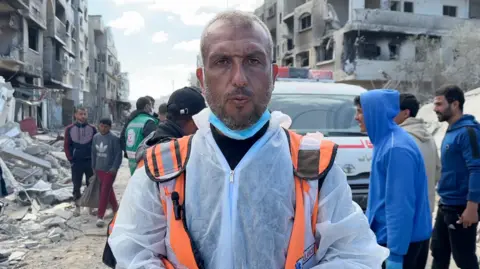
The Israeli government has banned the BBC and other international news organisations from entering Gaza and reporting independently. We depend on trusted local journalists to record the experiences of people like those who are searching for the missing.
At the end of every day, Mr Homs updates the list of those found. His team excavates the rubble with care, aware that they are searching for fragments of broken humanity. Often what is recovered is no more than a pile of bones. Israel’s high explosive bombs blasted and mangled into pieces many of the dead. The bones and scraps of clothing are placed in white body bags upon which Mr Homs writes the Arabic word “majhoul”. It means “unidentified”.
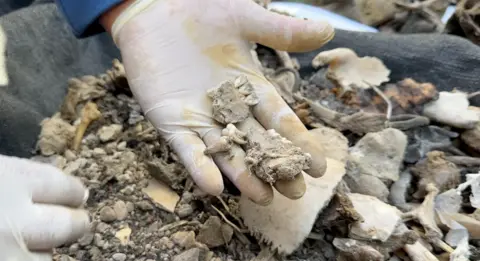
A resident of Rafah, Osama Saleh, went back to his home after the ceasefire and found a skeleton inside. The skull was fractured. Mr Saleh reckons the body lay there for four to five months. “We are humans with feeling…I can’t convey to you how miserable the tragedy is,” he says.
To be surrounded every day by the smell of decomposing bodies is a deeply unsettling experience, as those who have witnessed the aftermath of mass death will often testify.
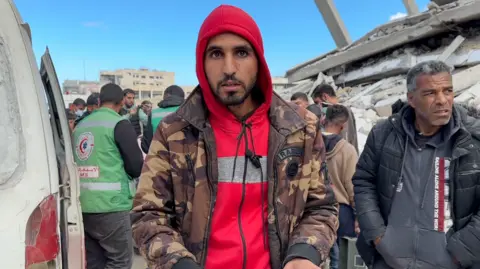
“The bodies are terrifying. We are seeing terror,” Osama Saleh says. “I swear it is a painful feeling, I have cried.”
Families have also been arriving at hospitals to search for remains. In the courtyard of the European Hospital in southern Gaza, collections of bones and clothing are spread out on body bags.
Abdul Salam al-Mughayer, 19, from Rafah, went missing in the Shaboura area; according to his uncle, Zaki, it was a place you didn’t come back from if you went there during the war. “So, we didn’t go to look for him there for that reason. We wouldn’t have returned.”
Zaki believes a set of bones and clothes in front of him belong to the missing Abdul Salam. He is standing with a hospital worker, Jihad Abu Khreis, waiting for Abdul Salam’s brother to arrive.
“It’s 99% certain the body is his,” Mr Abu Khreis says, “but now we need the final confirmation from his brother, the closest people to him, to make sure that the trousers and shoes are his.”
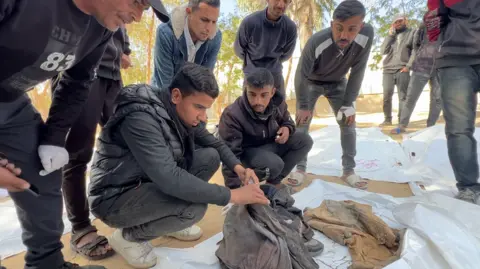
Soon after the brother arrived from the tented refugee camp of al-Mawasi, also in southern Gaza. He had a photograph of Abdul Salam on his phone. There was a photo of his running shoes.
He knelt before the body bag and pulled back the cover. He touched the skull, the clothes. He saw the shoes. There were tears in his eyes. The identification was complete.
Another family moved along the row of body bags. There was a grandmother, her son, an adult sister, and a toddler. The child was kept at the back of the group while the elderly woman and her son looked under the cover of the body bag. They stared for a few seconds and then embraced each other in grief.
After this, the family, helped by hospital workers, carried away the remains. They were weeping, but nobody cried aloud.
 Handout
HandoutAya al-Dabeh was 13 years old and was living with her family and hundreds of other refugees at a school in Tal al-Hawa, in Gaza City in the north. She was one of nine children.
One day at the start of the war Aya went to go to the bathroom upstairs at the school and – her family says – she was shot in the chest by an Israeli sniper. The Israel Defense Forces say they do not target civilians and blame Hamas for attacking from civilian areas. During the war the UN Human Rights Office said that that there has been “intense shooting by Israeli forces in densely populated areas resulting in apparently unlawful killings, including of unarmed bystanders.”
The family buried Aya beside the school, and her mother Lina al- Dabah, 43, wrapped her in a blanket “to protect her from the rain and the sun” in case the grave was disturbed and exposed to the elements.
When the Israeli military took over the school Lina fled south. She went with four other children – two daughters and two sons – to reunite with her husband who’d gone earlier with the couple’s other children. Lina had no option but to leave her daughter where she lay, hoping to come back and recover the remains for a proper burial once peace came.
“Aya was a very kind girl, and everyone loved her. She used to love everyone, her teachers and her studies, and she was very good at school. She wished well for everyone,” Lina says. When the ceasefire came Lina asked relatives still living in the north to check up on Aya’s grave. The news was devastating.
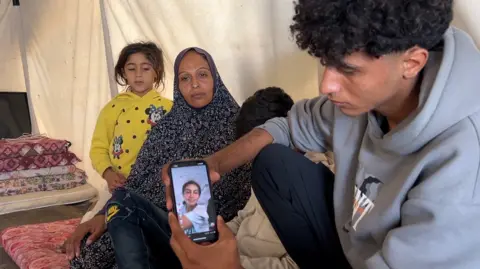
“They informed us that her head was in one place, her legs were in another, while her ribs were somewhere else. The one who went to visit her was shocked and sent us the pictures,” she says.
“When I saw her, I couldn’t understand how my daughter was taken out of her grave, and how did the dogs eat her? I can’t control my nerves.”
The relatives have collected the bones and soon Lina and her family will travel north to carry Aya’s remains to a proper grave. For Lina, there is grief with no end, and a question that has no answer – the same question that sits with so many parents who lost children in Gaza. What could they have done differently, the circumstances of the war being what they were?
“I couldn’t take her from where she was buried,” says Lina. Then she asks: “Where could I have taken her?”
With additional reporting by Malak Hassouneh, Alice Doyard, Adam Campbell.
Fergal Keane
Special correspondent

